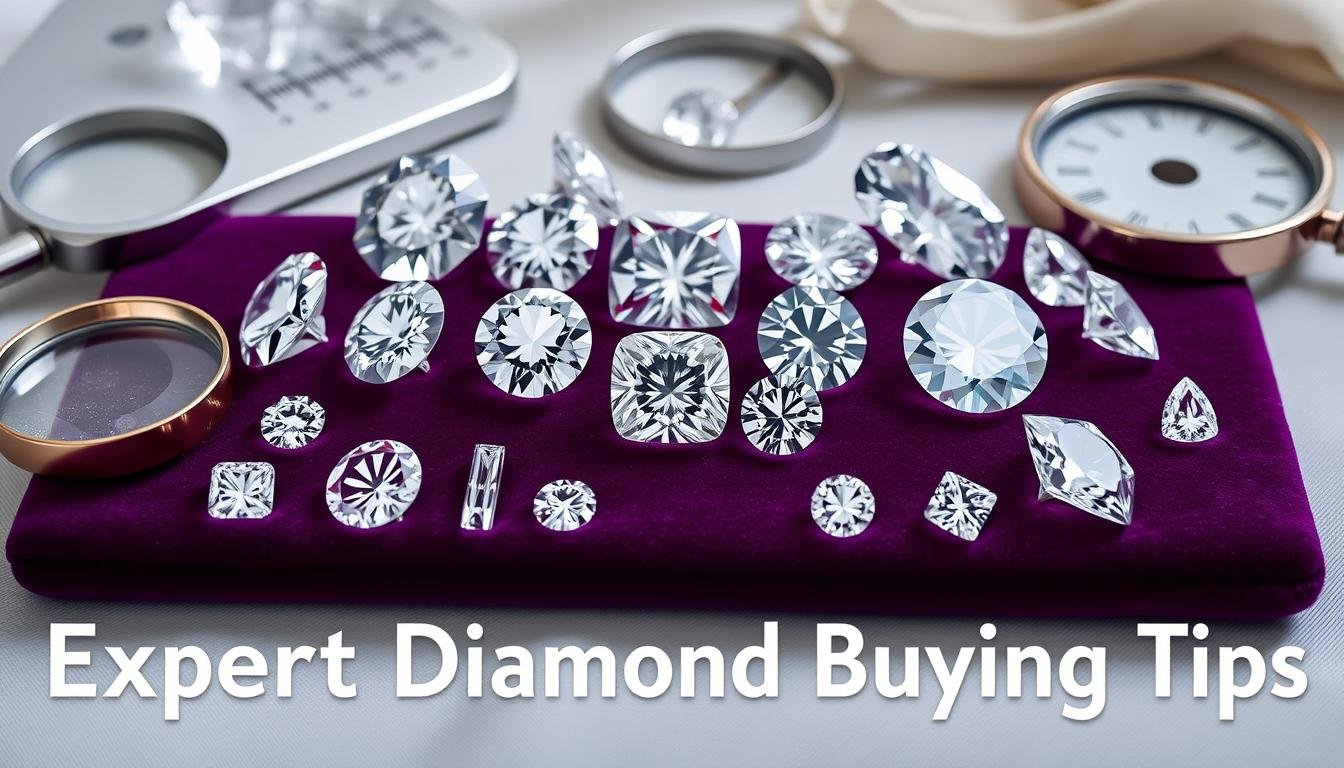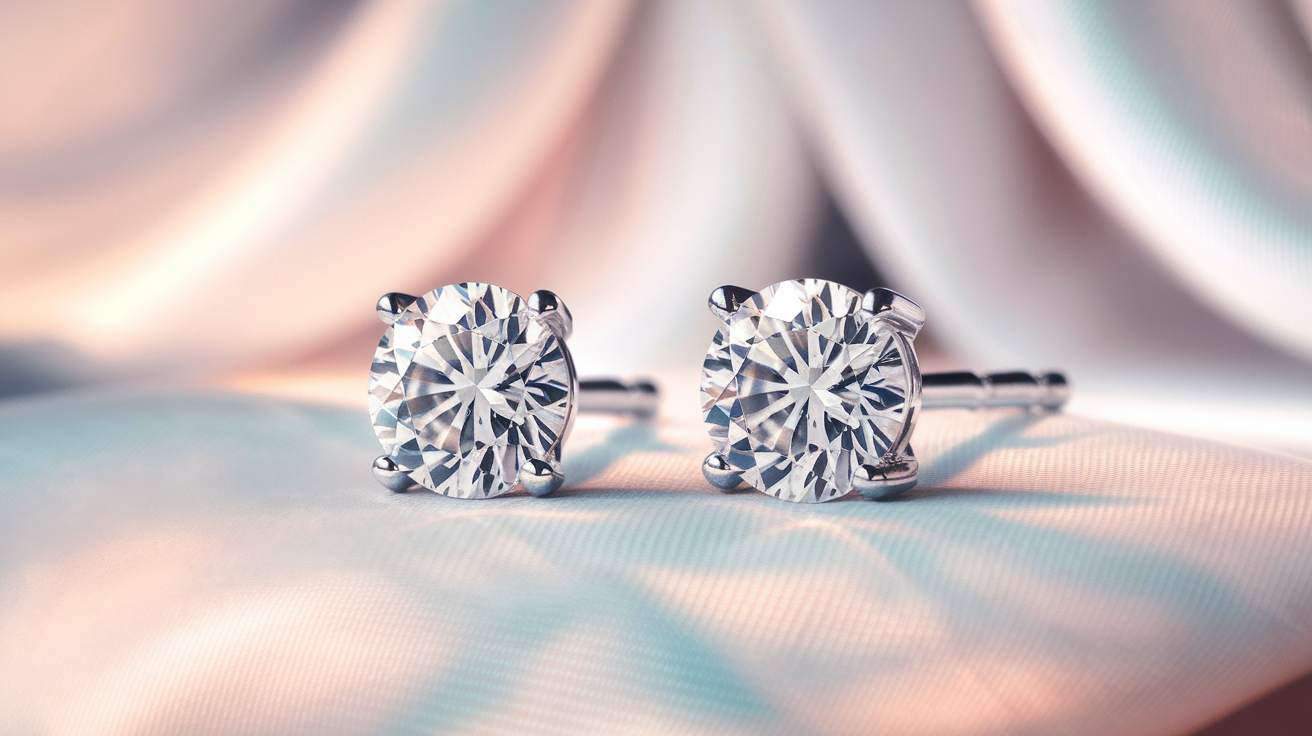Buying a diamond can seem daunting, whether it’s for an engagement ring or earrings. There are many factors to think about. But don’t worry, this guide will help you navigate the diamond buying process with ease.
We’ll cover everything from the 4Cs (cut, color, clarity, and carat) to setting a budget. This guide is for both first-time buyers and seasoned jewelry lovers. It will give you the knowledge to choose a diamond that fits your style and budget perfectly.
Key Takeaways
- Gain a comprehensive understanding of the 4Cs and how they impact diamond quality and value.
- Establish a realistic budget that aligns with your financial goals and personal preferences.
- Discover the key factors to consider when researching and evaluating potential diamond sellers.
- Learn how to effectively evaluate diamond cut quality to ensure maximum brilliance and sparkle.
- Uncover the importance of diamond certification and documentation for making an informed purchase.
By following this expert-guided diamond buying journey, you’ll be empowered to make a confident and informed decision. You’ll end up with a stunning diamond to cherish for years.
Understanding the Basics of Diamond Quality
When you buy a diamond, knowing the basics is key. The 4Cs of diamonds – Cut, Clarity, Color, and Carat – are the main criteria. Let’s explore each one.
The Four Cs Explained
The cut of a diamond affects its sparkle and shine. It’s about the stone’s shape, symmetry, and polish. Clarity shows if there are any flaws inside or on the surface. Color grades how clear the diamond is, with no color at all being the best. Carat measures the diamond’s weight and size.
Industry Standards and Grading Systems
Places like the Gemological Institute of America (GIA) and the American Gem Society (AGS) have set up diamond certification systems. These systems help buyers compare and understand diamond quality. They make it easier to find the right diamond for you.
Common Diamond Quality Myths
- Bigger is always better: The carat weight of a diamond is not the sole indicator of its quality or value.
- Flawless diamonds are the most valuable: Diamonds with minor inclusions or blemishes can still be of exceptional quality and value.
- Color is the most important factor: While color is essential, the cut of a diamond plays a crucial role in its overall appearance and brilliance.
Knowing the 4Cs and industry standards helps you choose the right diamond. It ensures you find one that fits your style and budget.
Setting Your Diamond Budget and Priorities
When you’re shopping for an engagement ring or a diamond, setting a budget is key. Your budget should match what you can afford and what you want. Here are some important things to think about when setting your diamond buying priorities:
- Know your spending limit: Figure out how much you can spend on a diamond. Think about other money you need to spend and your goals.
- Choose what matters most: Pick the diamond buying tips – cut, color, clarity, and carat – that are most important to you. Be ready to make some compromises to stay within your budget.
- Think about the occasion and who it’s for: If it’s for a special event, like a graduation or birthday, think about the person’s style and age. This will help you choose the right diamond.
- Look into financing: If your dream diamond is a bit too pricey, look into financing options. This could be payment plans or loans to help make it more affordable.
Finding the right balance between your budget and what you want in a diamond is crucial. It will help you find a diamond that’s perfect for the occasion and the person it’s for.
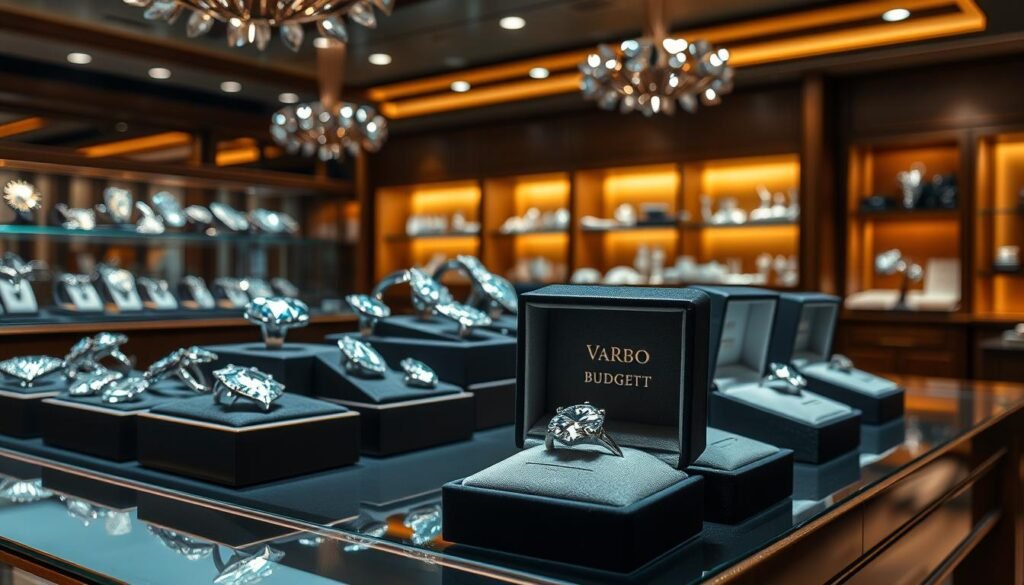
“The key to a successful diamond purchase is understanding your budget and prioritizing the most important diamond characteristics to you.”
The 5-Step Guide to Buying a Diamond
Buying a diamond can seem overwhelming, but it doesn’t have to be. With the right steps, you can find a diamond that fits your budget and style. Here’s a simple five-step guide to help you buy a diamond with confidence:
Research and Education
Start by learning about the 5-step guide to buying a diamond. Understand the 4 Cs: Carat, Cut, Color, and Clarity. Knowing these will help you make a smart choice.
Finding Reputable Sellers
After learning the basics, look for reliable diamond sellers. Check both online and in-person shops. Choose sellers known for honesty and good customer service. Look for certifications and reviews to find a trustworthy seller.
Making the Final Decision
Now, it’s time to choose. Think about your budget, what you like, and the diamond’s quality. Remember, the cut quality is key for beauty and value.
“The most important factor in determining a diamond’s value is its cut quality, as this is what gives the stone its brilliance and fire.”
By following this 5-step guide to buying a diamond, you’ll find the perfect diamond. The diamond buying tips here will guide you to make a smart choice.
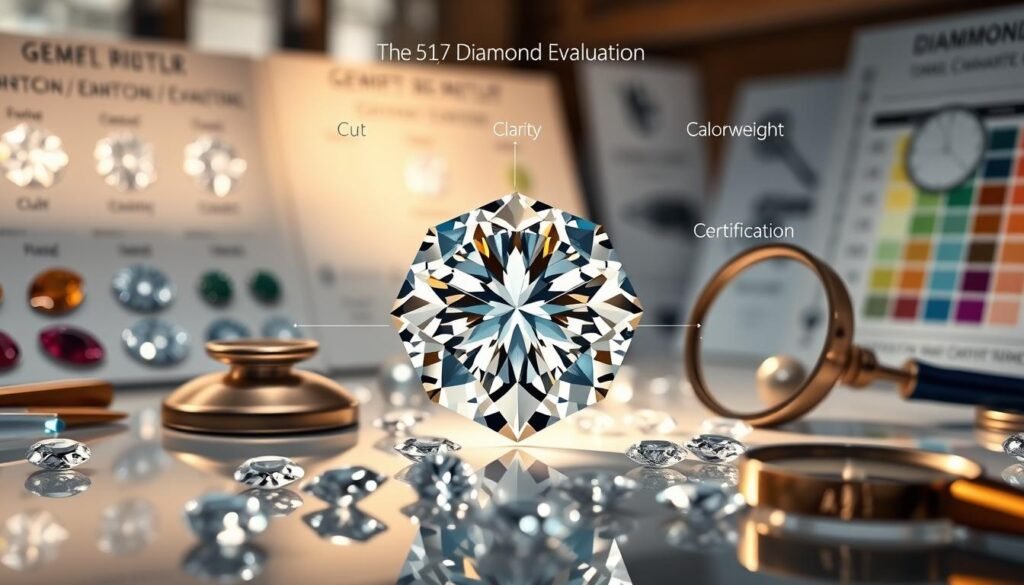
Evaluating Diamond Cut Quality
The 4Cs of diamonds highlight the cut as key. It affects a diamond’s sparkle, fire, and look. Knowing how to judge cut quality is vital for a valuable, beautiful stone.
The cut shapes how a diamond shines. A well-cut diamond sparkles and glows. But a bad cut can make a diamond dull, even with great clarity and color.
- Ideal Proportions: The best depth, table, and measurements for light reflection.
- Symmetry: The alignment and uniformity of facets, enhancing the diamond’s beauty.
- Polish: The smoothness of the diamond’s surface, affecting light reflection.
For accurate cut quality, trust the Gemological Institute of America (GIA). They use advanced methods to grade diamonds, helping you choose wisely.
| Cut Grade | Description | Brilliance | Value |
|---|---|---|---|
| Ideal | Optimal balance of proportions, symmetry, and polish | Exceptional | Highest |
| Excellent | Excellent proportions, symmetry, and polish | Excellent | Very High |
| Very Good | Proportions, symmetry, and polish are very good | Very Good | High |
| Good | Proportions, symmetry, and polish are good | Good | Moderate |
| Fair | Proportions, symmetry, and polish are fair | Fair | Lower |
| Poor | Proportions, symmetry, and polish are poor | Poor | Lowest |
Understanding diamond cut quality helps you choose the right diamond. It’s about finding a stone that shows your love and commitment.
“The cut of a diamond is its most important characteristic, as it determines the stone’s overall brilliance and fire.”
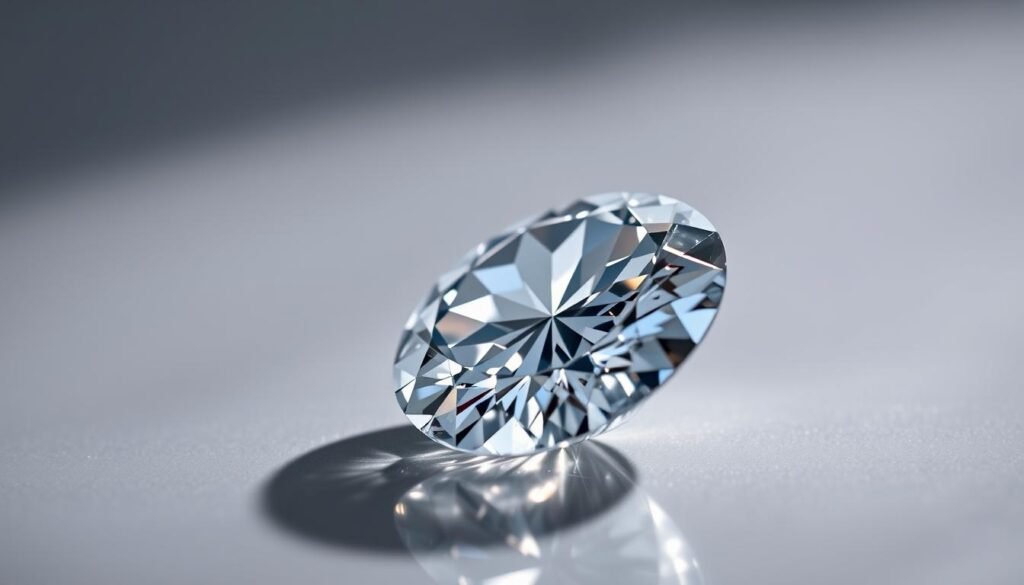
Decoding Diamond Clarity Grades
Clarity is key among the 4Cs of diamonds and greatly affects a diamond’s value. Knowing about diamond clarity grades helps you make a smart choice. Let’s explore the details of diamond clarity grades and how they impact a diamond’s quality and price.
Understanding Inclusions and Blemishes
Diamonds form deep in the earth and can have natural flaws. These are called inclusions and blemishes. Inclusions are inside the diamond, and blemishes are on the surface. They are graded from Flawless (FL) to Included (I3), with lower grades showing more flaws.
Clarity Grade Impact on Value
The diamond clarity grade really matters for its value. Diamonds with high clarity, like Flawless (FL) or Internally Flawless (IF), are rare and pricey. They have fewer or no flaws. On the other hand, diamonds with lower clarity, like Included (I1, I2, I3), have more visible flaws. This can make them look less appealing and cost less.
Best Clarity Grades for Your Budget
- For a tighter budget, a VS1 or VS2 (Very Slightly Included) diamond is a good choice. It balances quality and cost well.
- If you can spend more, a VVS1 or VVS2 (Very, Very Slightly Included) diamond offers top-notch clarity and shine.
- The right clarity grade for you depends on your budget and what you value most in a diamond.

Understanding diamond clarity grades helps you choose wisely. You can find a diamond that fits your budget and looks great to you.
Diamond Color Scale: What You Need to Know
The 4Cs of diamonds include cut, clarity, color, and carat. The color of a diamond greatly affects its look and value. It can range from colorless to light yellow or brown.
The color scale for diamonds uses letters, with “D” being the highest (colorless) and “Z” the lowest (light yellow or brown). Diamonds with higher color grades are rarer and more expensive. Those with lower grades are often more affordable.
- Colorless diamonds (grades D-F) are the most valuable and sought-after, as they offer the greatest brilliance and fire.
- Near-colorless diamonds (grades G-J) are also highly desirable, with only minor traces of color that are often unnoticeable to the untrained eye.
- Faint yellow or brown diamonds (grades K-M) have a more noticeable tint, which can affect their sparkle and brilliance.
- Fancy-colored diamonds (grades N-Z) are rarer and can be highly valuable, but their color may not be as desirable for traditional engagement rings.
When choosing a diamond, think about what you like and what you can spend. A higher color grade might cost more but can look stunning. Knowing the diamond color scale helps you pick the right diamond for your style and budget.
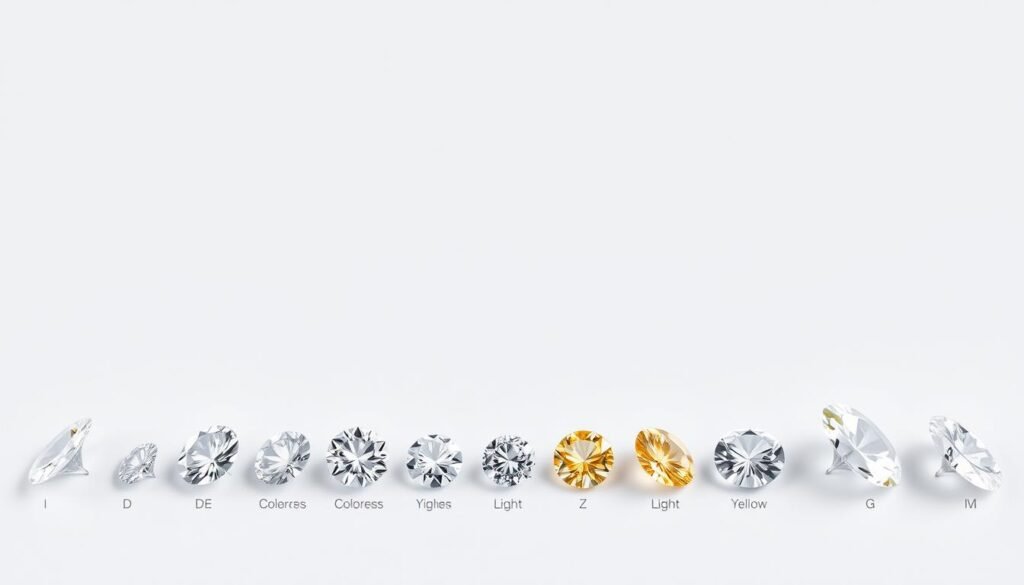
Understanding Diamond Carat Weight and Size
Exploring diamond carat weight shows us how weight and size differ. The carat measures the diamond’s weight, not its size. So, two diamonds of the same weight can look different in size, based on their 4Cs of diamonds.
Size vs. Weight Relationship
The size of a diamond depends more on its cut quality. A well-cut diamond looks bigger than a poorly cut one of the same weight. This is because a good cut reflects light better, making the diamond seem larger. On the other hand, a bad cut can make a diamond look smaller due to light loss and poor shape.
Price Points Across Carat Ranges
Diamond prices change with carat weight. Generally, bigger diamonds cost more per carat. This is because larger diamonds are rarer and more sought after. But, remember, other 4Cs like cut, color, and clarity also affect a diamond’s value and price.
| Carat Range | Approximate Price Range* |
|---|---|
| 0.50 – 0.99 carats | $2,000 – $6,000 |
| 1.00 – 1.49 carats | $6,000 – $12,000 |
| 1.50 – 1.99 carats | $12,000 – $18,000 |
| 2.00 – 2.49 carats | $18,000 – $30,000 |
*Prices are approximate and may vary based on the diamond’s 4Cs of diamonds, including cut, color, clarity, and other market factors.
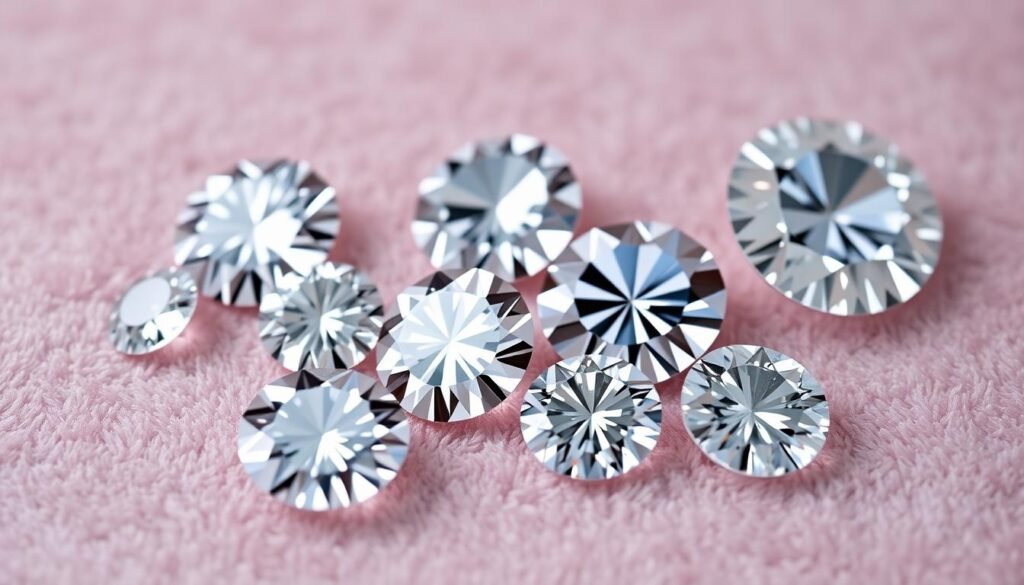
“Understanding the relationship between diamond carat weight and size is essential in ensuring you get the most value for your money when purchasing a diamond.”
Diamond Certification and Documentation
When you buy a diamond, getting the right certification is key. It shows the diamond’s quality and value. The Gemological Institute of America (GIA) and the American Gem Society are top labs for this. They check the diamond’s cut, clarity, color, and weight.
At first, reading a diamond certificate might seem hard. But, it helps you feel sure about your choice. It shows the diamond’s grade for each “Four C” – cut, clarity, color, and weight. This lets you compare it to what’s standard in the industry.
| Grading Laboratory | Certification Process | Key Factors Evaluated |
|---|---|---|
| Gemological Institute of America (GIA) | Comprehensive, industry-leading evaluation | Cut, clarity, color, carat weight |
| American Gem Society (AGS) | Rigorous, unbiased assessment | Cut, clarity, color, carat weight |
Buying a certified diamond gives you peace of mind. It means you know you’re getting what you paid for. With diamond buying tips and knowing the 4Cs, you can pick a diamond that fits your budget and style.
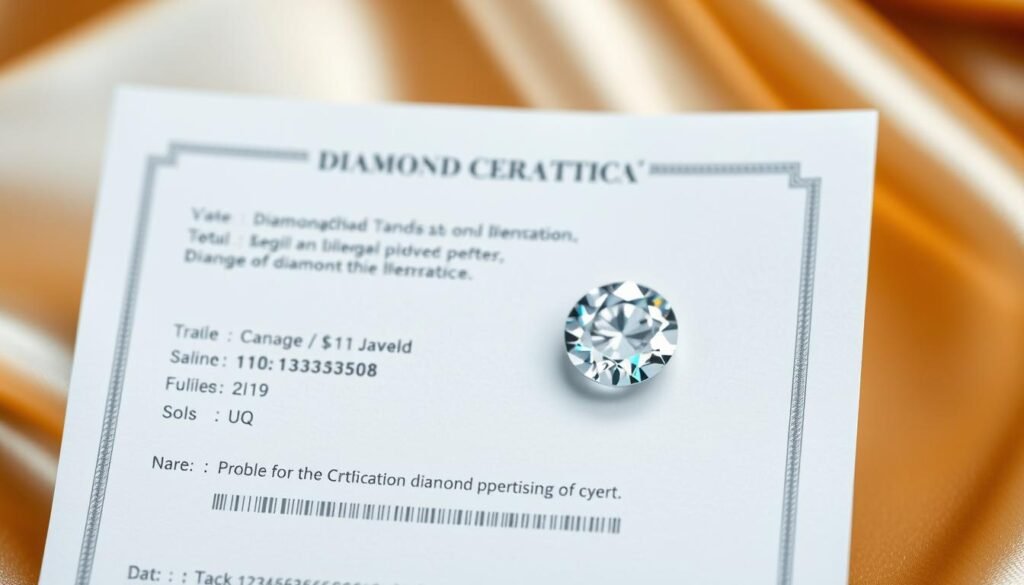
“Certification is the cornerstone of a diamond purchase, giving you the assurance that the stone you’re buying is exactly what you’re being told it is.”
Ethical and Sustainable Diamond Sourcing
We all have a duty to buy diamonds that are ethically and sustainably sourced. This part talks about the need for conflict-free certification. It also explains the difference between lab-grown and natural diamonds. This helps you make choices that match your values.
Conflict-Free Certification
Diamonds with a Kimberley Process Certification are conflict-free. This means they weren’t mined in war zones or used to fund armed conflicts. Choosing certified conflict-free diamonds ensures your purchase doesn’t support human rights abuses or destabilize areas.
Lab-Grown vs. Natural Diamonds
Lab-grown diamonds are a new option compared to traditional natural diamonds. They look and feel the same but are more eco-friendly. Natural diamonds, mined from the earth, can harm the environment and society. Think about the benefits and drawbacks of each to find the best fit for your values.

Hi, I’m Jimmy, the founder of Brilliant Jewelry Guide. With years of experience and a passion for timeless jewelry, I’m here to help you find pieces that tell your story and celebrate life’s special moments.
Disclaimer: This article contains affiliate links, which means we may earn a small commission if you purchase through them, without any additional cost to you. The content on this website was developed with assistance from AI.
